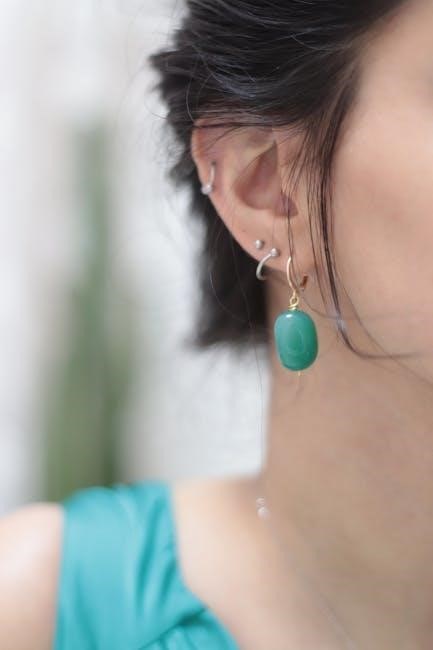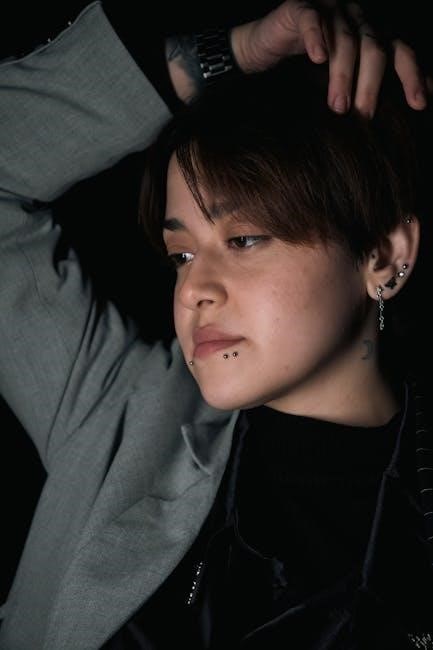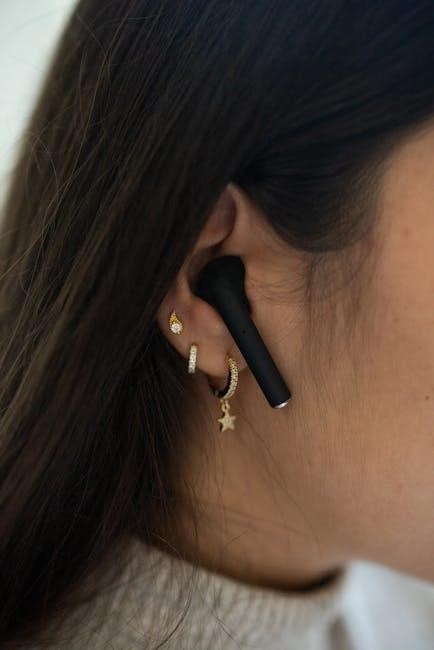Ear piercings are a popular form of self-expression, offering versatility in styles and locations․ From lobes to cartilage, they allow personalization, making them a timeless fashion choice for many․
Popular Types of Ear Piercings
Ear piercings come in various styles, each offering unique appeal․ The lobe piercing is the most common, known for its simplicity and versatility․ Helix piercings, located on the upper rim of the ear, are gaining popularity for their sleek appearance․ Tragus piercings, positioned on the small flap near the ear canal, are favored for their subtle look․ Industrial piercings, which involve two piercings connected by a barbell, offer an edgy aesthetic․ Each type caters to different preferences, allowing individuals to express their personality through their choice of piercing․ Whether minimalist or bold, these styles provide endless options for personalization and self-expression․
Importance of Choosing the Right Jewelry
Selecting the right jewelry for your ear piercing is crucial for comfort, hygiene, and style․ Hypoallergenic materials like titanium, surgical steel, or 14k gold are recommended to minimize irritation and allergic reactions․ Starting with simple studs is often advised for new piercings, as they are gentle on the skin and promote healing․ The jewelry’s quality and fit can significantly impact the piercing’s appearance and longevity․ Choosing the wrong material or style may lead to discomfort or prolonged healing times․ Therefore, prioritizing hypoallergenic, well-fitting options ensures a positive experience and enhances the overall look of your piercing․
Types of Ear Piercings
Ear piercings offer a variety of options, from the classic lobe to cartilage piercings like helix, tragus, and daith․ Each type has unique appeal and placement possibilities․
Lobe Piercing: The Most Beginner-Friendly Option
Lobe piercings are the most popular and easiest for beginners, located on the soft, fleshy part of the earlobe․ They are relatively painless and heal quickly, typically within 6-8 weeks․ Suitable for all ear types, lobe piercings are versatile, allowing for single or multiple piercings․ Ideal for first-timers, they offer a wide range of jewelry options, from studs to hoops․ Hypoallergenic materials like surgical steel or gold are recommended to minimize irritation․ This piercing is perfect for those seeking a low-maintenance yet stylish option, making it a timeless choice for self-expression․
Cartilage Piercings: Helix, Tragus, and Daith
Cartilage piercings are popular for their unique aesthetic and variety of options․ The helix piercing is located on the upper rim of the ear, offering a sleek look, while the tragus piercing is situated on the small flap by the ear canal, adding a delicate touch․ The daith piercing, placed in the inner ear fold, has gained popularity for its bold appeal․ These piercings are considered more painful than lobe piercings and require longer healing times, typically ranging from 3 to 9 months․ Proper aftercare is essential to promote healing and prevent complications․ Jewelry options include studs, hoops, and captive bead rings, allowing for personalized styling․
Pain Levels and Healing Times
Pain levels vary by piercing type, with lobe piercings being the least painful and cartilage piercings more so․ Healing times range from 6 weeks for lobes to several months for cartilage․
Understanding Pain Levels: From Lobe to Cartilage
Lobe piercings are typically the least painful, as the tissue is soft and fleshy․ Cartilage piercings, such as the helix, tragus, or daith, involve tougher tissue, causing moderate to higher pain․ Pain intensity varies per individual, with factors like anxiety and piercing technique influencing the experience․ Some people describe cartilage piercings as a sharp, quick sting, while others find it more uncomfortable․ Overall, pain is subjective, but lobes are generally more comfortable for beginners, while cartilage piercings may require higher tolerance․
Healing Process and Timeline for Different Piercings
The healing process for ear piercings varies depending on the location․ Lobe piercings typically heal within 6 to 8 weeks, while cartilage piercings, like the helix or tragus, may take 3 to 9 months․ Proper aftercare, including regular cleaning and avoiding irritants, is crucial for preventing complications․ During healing, some swelling, redness, or discharge may occur, but these symptoms usually subside with time․ It’s important to avoid changing jewelry too soon, as this can prolong healing․ If signs of infection arise, such as increased redness or pus, professional advice is recommended to ensure proper recovery․

Ear Piercing Jewelry Options

Ear piercing jewelry comes in various styles, including studs, hoops, and captive bead rings․ Hypoallergenic materials like titanium and surgical steel are ideal for sensitive skin and new piercings․
Choosing Hypoallergenic Materials
Selecting hypoallergenic materials is crucial for minimizing irritation and allergic reactions, especially for new piercings․ Metals like surgical stainless steel, titanium, and 14k gold are highly recommended․ These options are less likely to cause skin sensitivity and promote healing․ Avoid low-quality materials, such as plated jewelry, as they can contain allergens like nickel․ Opting for solid gold or platinum ensures durability and safety․ Always prioritize materials certified as nickel-free to ensure comfort and reduce the risk of adverse reactions․ This choice is particularly important for those with sensitive skin or a history of allergies․
Styling Tips: Studs, Hoops, and Captive Bead Rings
Studs are ideal for a minimalist look, offering simplicity and versatility․ Hoops add a bold, statement-making flair and can be paired with various outfits․ Captive bead rings provide a sleek, modern aesthetic with a seamless design․ For new piercings, studs are often recommended as they are easy to clean and less likely to irritate the area․ Hoops and captive bead rings can be introduced once the piercing is fully healed․ Consider the size and thickness of the jewelry to ensure comfort and style․ Mixing and matching these options allows for a personalized look that suits your unique taste and preferences․

Aftercare and Maintenance
Proper care is essential for healing․ Clean piercings with saline solution, avoid tight clothing, and keep the area dry․ Regular maintenance prevents infections and promotes healing․

Proper Cleaning and Care Techniques
Proper cleaning is vital for ear piercing aftercare․ Use a saline solution or mild soap to clean the area twice daily․ Gently rotate the jewelry to ensure even cleaning․ Avoid submerging the piercing in water, such as swimming, until fully healed; Refrain from touching the piercing unnecessarily, as this can introduce bacteria․ Keep the area dry and avoid tight clothing that may irritate the piercing․ Regularly inspect the jewelry to ensure it is secure and not too tight․ Following these care techniques promotes healing, reduces the risk of infection, and ensures a smooth recovery process for your ear piercings․

Signs of Infection and When to Seek Help
Identifying infection signs early is crucial for proper healing․ Redness, swelling, increased pain, or pus-like discharge around the piercing may indicate an infection․ If these symptoms persist or worsen, seek medical attention․ Fever or chills, though rare, are serious signs requiring immediate care․ Avoid removing the jewelry yourself, as this can trap bacteria and lead to an abscess․ Consult a professional piercer or doctor if you notice unusual symptoms or if the piercing doesn’t improve with proper aftercare․ Prompt treatment can prevent complications and ensure a smooth recovery․ Regular monitoring and maintaining hygiene are key to avoiding infections and ensuring your ear piercing heals successfully․

Additional Considerations
Consider your lifestyle, metal sensitivities, and personal style before getting pierced․ Choose hypoallergenic jewelry to minimize reactions and ensure comfort for long-term wear․

How to Choose the Right Piercer
Choosing the right piercer is crucial for a safe and successful experience; Look for professionals with extensive experience and positive reviews․ Ensure they use sterilized equipment and follow proper hygiene practices․ A reputable piercer will guide you through the process, answer questions, and help select the best jewelry for your piercing․ They should also provide clear aftercare instructions to promote healing․ Don’t hesitate to ask about their certifications or observe their workspace to confirm cleanliness․ Prioritizing a skilled piercer ensures your piercing is done correctly, minimizing risks and enhancing your overall satisfaction with the final result․

Ear Piercing for Sensitive Skin or Allergies
If you have sensitive skin or allergies, it’s essential to take extra precautions when getting an ear piercing․ Opt for hypoallergenic jewelry materials like titanium, surgical steel, or 14k gold to minimize irritation․ Avoid low-quality metals that can trigger allergic reactions․ Consider consulting a dermatologist before piercing to ensure safety․ After piercing, maintain meticulous aftercare to prevent infections․ Gentle cleaning with saline solution and avoiding harsh chemicals can help sensitive skin heal smoothly․ Choosing a reputable piercer who understands your needs is also crucial for a successful piercing experience without complications․

